
We all knew the day would come when science found a way to combine main courses with desserts in an unholy marriage of sweet and savory—and thus is born the Turpumpkin™! All we can say is…
Happy Fearsgiving!


We all knew the day would come when science found a way to combine main courses with desserts in an unholy marriage of sweet and savory—and thus is born the Turpumpkin™! All we can say is…
Happy Fearsgiving!
 Beating the rush before the post-Thanksgiving shopping season goes into overdrive this weekend, e-book distributor DriveThru Fiction—along with its sister sites DriveThru Comics and DriveThru RPG—has launched its annual Black Friday and Cyber Monday Sale, during which you can purchase a ton of digital books and comics at special prices! It runs from now to November 26—and yes, you’ll need to set up an account (it’s free) to take advantage of this promotion.
Beating the rush before the post-Thanksgiving shopping season goes into overdrive this weekend, e-book distributor DriveThru Fiction—along with its sister sites DriveThru Comics and DriveThru RPG—has launched its annual Black Friday and Cyber Monday Sale, during which you can purchase a ton of digital books and comics at special prices! It runs from now to November 26—and yes, you’ll need to set up an account (it’s free) to take advantage of this promotion.
Included among the many participating publishers is StarWarp Concepts (of course), which means you can take advantage of some sweet discounts while the sale’s running. So head on over there now and get to shopping!
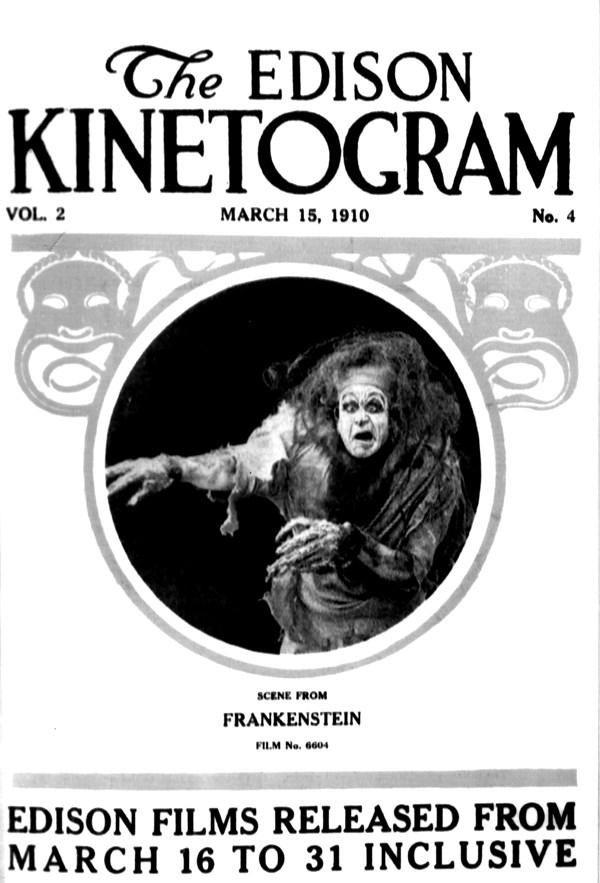 If you’re a fan of classic monsters like Dracula, the Wolfman, and Frankenstein’s Monster, then you’re probably aware that 2018 is the 200th anniversary of Mary Shelley’s iconic novel Frankenstein, or the Modern Prometheus, first unleashed on the public in January 1818.
If you’re a fan of classic monsters like Dracula, the Wolfman, and Frankenstein’s Monster, then you’re probably aware that 2018 is the 200th anniversary of Mary Shelley’s iconic novel Frankenstein, or the Modern Prometheus, first unleashed on the public in January 1818.
With that in mind, the timing couldn’t be better for the U.S. Library of Congress to make available a restored print of world-famous inventor Thomas Edison’s 1910 silent-movie adaptation—the first time Frankenstein’s Monster stalked the silver screen!
Frankenstein was a self-described “liberal adaptation of Mrs. Shelley’s famous story” by writer/director J. Searle Dawley that was produced by Edison and starred Augustus Phillips as Frankenstein (no first name of Victor given; he even signs a love letter “Frankenstein”!); Mary Fuller as his bride-to-be Elizabeth; and Charles Ogle as the monster. It runs just over 13 minutes but packs in a lot of melodrama—and scenery chewing—in that short time. (Well, overacting was a staple of silent movies.)
It’s also surprisingly gruesome in one scene. Although Frankenstein doesn’t dig up graves and sew corpses together but instead uses chemical magic to “grow” his monster in cauldron-like pot—one of those liberties taken by Dawley in his screenplay—the transformation of the creature from smoking chemical vapors to full-size horror involves a stage when it bubbles up into a gore-covered skeleton whose twitchy right hand seems to be grasping for the audience—I’m sure it scared the crap out of moviegoers back in the day!
Do yourself a favor and check it out!
 Stan “The Man” Lee passed away on Monday at the age of 95, and I’ve gotta say this one actually hurts.
Stan “The Man” Lee passed away on Monday at the age of 95, and I’ve gotta say this one actually hurts.
Sure, there have been celebrities and creators I’ve greatly admired who’ve passed away—Ray Bradbury, Harlan Ellison, Robin Williams, John Belushi, Steve Gerber, Jack Kirby, Steve Ditko—but Stan Lee was my first writing influence; the mastermind who understood there was more to comics than people in costumes bashing the crap out of each other; that heroes could have feet of clay and suffer crises of conscience and stumble through bad days and worry about paying the bills, just like any real person, but through sheer willpower and fierce determination they could overcome those obstacles—so long as they never did it at the cost of other people.
After all, “with great power there must also come…great responsibility.”
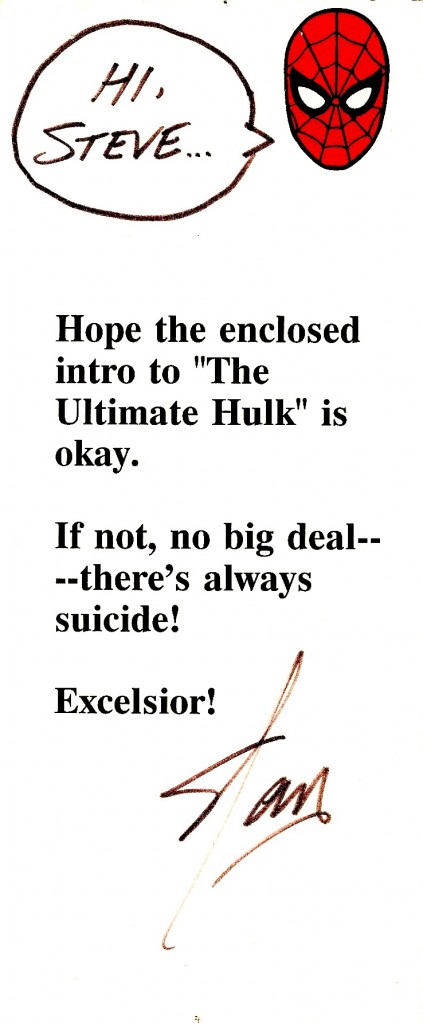 Back in my editing days at indie publisher ibooks, inc., I had two occasions to work with Stan Lee—not closely, but close enough for a nerdy fan to say he’d been involved in a few projects headlined by a living legend:
Back in my editing days at indie publisher ibooks, inc., I had two occasions to work with Stan Lee—not closely, but close enough for a nerdy fan to say he’d been involved in a few projects headlined by a living legend:
In 1998, I was tasked with editing The Ultimate Hulk, an anthology of Hulk short stories by various writers; Stan Lee and Peter David were credited as its editors on the cover. At one point I contacted Stan about an intro he needed to write for the book; when it showed up in the mail, the note you see here was attached to it.
Oh, that Stan!
Then in 2005, I was hired to write captions and dialogue for Stan Lee’s Alexa, a comic loosely based on a novel series called Stan Lee’s Riftworld, about a comic artist who can open portals to other dimensions (the publisher she worked for was based on Stan).
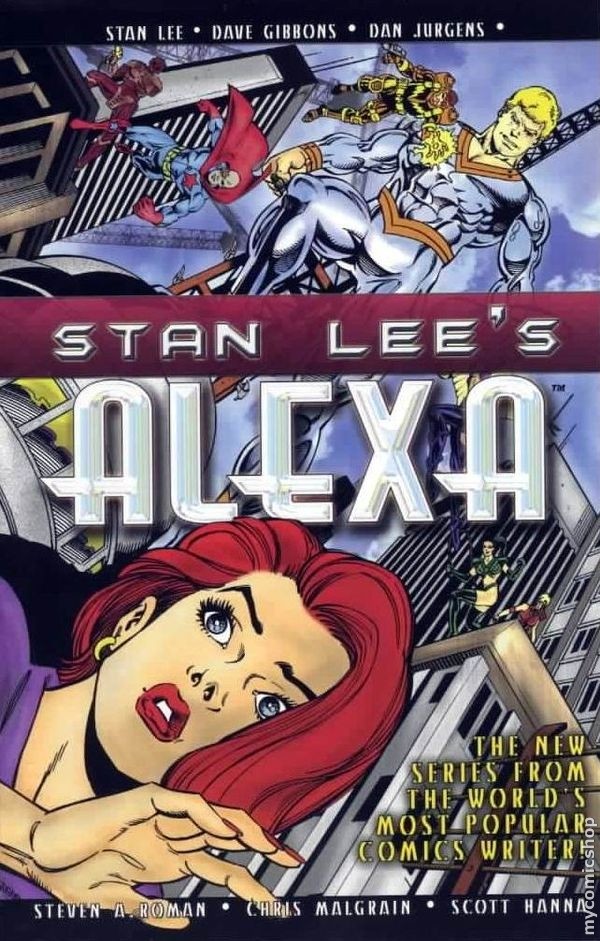 I tried to write it like The Man (since the conceit was that Stan plotted it), but one day he called me and yelled, “What is it with this script?! It’s like every third word is boldfaced! Where did you ever learn to write like that?!”
I tried to write it like The Man (since the conceit was that Stan plotted it), but one day he called me and yelled, “What is it with this script?! It’s like every third word is boldfaced! Where did you ever learn to write like that?!”
I paused—I mean, Stan Lee was yelling at me!—and then said, “Uhhh…from you.”
There was one other comic project I was supposed to be the writer for, in those ibooks, inc. days, that involved adapting/updating The Inmates, a film treatment that Stan wrote in 1971 for a planned collaboration with French director Alain Resnais. From what I remember, the update was about a space princess arriving on Earth and being locked away in an asylum; she escapes and eventually falls in love with the man who helps hide her from the authorities. (Something like that; I can’t remember the exact details. I think the title changed to The Visitor.) What scuttled the project, as well as the concluding two issues of Alexa, was the death of ibooks, inc. publisher Byron Preiss in 2005, shortly after Alexa #1 came out.
Stan Lee—Stanley Martin Lieber—always wanted to be a literary icon; to write The Great American Novel. In a way, he accomplished both goals—it just took hundreds of characters and thousands of pages and a ton of illustrations to tell the story. And we’ll never get tired of re-reading it.
Thanks, Mr. Lee, for everything.
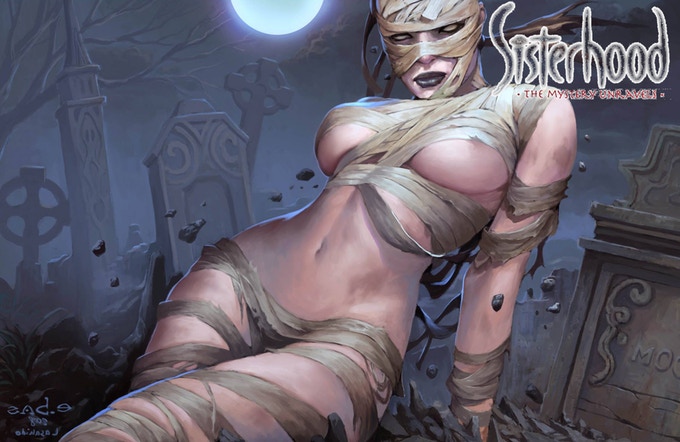
Hey, Lorelei fans! If you enjoy our soul-stealing femme fatale, then you should check out Sisterhood: The Mystery Unravels, a Kickstarter comic project from SWC friend Richard Boom, for whom I did a ton of comic reviews at his Comics for Sinners site. To quote Richard’s pitch for the series:
For several centuries the ancient order of Justice has laid dormant, but the magical power of the Justice Gems have been released during an Egyptian archeological dig and now all over the world the mummified Priestesses of Justice come back to life. As supernatural evils threaten human society through the next decades, the Sisterhood will be there to guard and protect.
Currently, four issues have already been completed, with another four in the works. If you’d like to support Richard’s dream project, you have until December 3 to join his growing number of backers, so head on over there now and check it out.
Geez—who knew ancient mummies could be so sexy!
 Today is the launch of the Love Your Bookstore Initiative, a collaboration between industry magazine Publishers Weekly and Sourcebooks in which they make a pretty simple and easy challenge to all lovers of literature in exchange for the chance to win free books:
Today is the launch of the Love Your Bookstore Initiative, a collaboration between industry magazine Publishers Weekly and Sourcebooks in which they make a pretty simple and easy challenge to all lovers of literature in exchange for the chance to win free books:
“Celebrate your favorite bookstore by posting a photo from inside the store with a favorite book (or bookseller!) and use #loveyourbookstore in the caption to share the love!”
Now, it’s a given you probably won’t find any of our titles in your local bookstores—either indie or mainstream—since most shops won’t stock a book unless they’re certain they can move copies and indie titles are too risky an investment, but that doesn’t mean SWC doesn’t support this initiative; hell, bookstores are some of our favorite places!
Love Your Bookstore Week runs November 10–16. For more information, visit the Love Your Bookstore website.
 It’s true! Not only did the original king of the monsters celebrate his 85th anniversary back in March, but he’s returned to the Broadway stages of New York City where producer Carl Denham made the mistake of trying to exploit a giant gorilla with no acting experience who wouldn’t take direction. Hopefully, this time it’ll go better!
It’s true! Not only did the original king of the monsters celebrate his 85th anniversary back in March, but he’s returned to the Broadway stages of New York City where producer Carl Denham made the mistake of trying to exploit a giant gorilla with no acting experience who wouldn’t take direction. Hopefully, this time it’ll go better!
Tonight is the opening night for King Kong, a mega-budgeted musical stage adaptation of the creation of Merian C. Cooper and Edgar Wallace. According to the Broadway magazine Playbill, it features a one-ton, six-meter-tall silverback gorilla puppet as its star, and is written by Olivier Award-winning book writer Jack Thorne (Harry Potter and the Cursed Child) with a score by Marius de Vries (Moulin Rouge) and songs by Eddie Perfect. It follows a 2013 world premiere in Melbourne, Australia. Sounds exciting, right?
But Kong hasn’t influenced only a Broadway musical—he also inspired all of us at StarWarp Concepts to add the story of the king of the simian monsters to our line of Illustrated Classics!
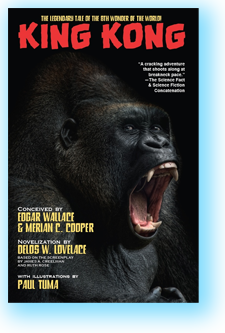 King Kong is an e-book-only republication of the 1932 novelization of the original movie classic. Written by Delos W. Lovelace, based on the story by Edgar Wallace and Merian C. Cooper and the screenplay by James A. Creelman and Ruth Rose, it includes scenes that didn’t appear in the final cut of the film—including the notorious “spider pit” sequence in which Kong’s human pursuers are attacked by horrific arachnids and insects. Our version features six original black-and-white illustrations by comics artist Paul Tuma, whose pulp-influenced style has appeared in the pages of The Twilight Avenger, Flare, and Dan Turner: Hollywood Detective.
King Kong is an e-book-only republication of the 1932 novelization of the original movie classic. Written by Delos W. Lovelace, based on the story by Edgar Wallace and Merian C. Cooper and the screenplay by James A. Creelman and Ruth Rose, it includes scenes that didn’t appear in the final cut of the film—including the notorious “spider pit” sequence in which Kong’s human pursuers are attacked by horrific arachnids and insects. Our version features six original black-and-white illustrations by comics artist Paul Tuma, whose pulp-influenced style has appeared in the pages of The Twilight Avenger, Flare, and Dan Turner: Hollywood Detective.
Not familiar with the beauty-and-the-beast story of Kong and his “love interest,” Ann Darrow (who was played in the 1933 original by the queen of the scream queens, Fay Wray)? Well, here’s our edition’s back-cover copy to bring you up-to-date:
Ann Darrow was a down-on-her-luck actress struggling to survive in Depression-era New York when she met moviemaker Carl Denham. He offered her the starring role in his latest film: a documentary about a long-lost island—and the godlike ape named Kong rumored to live there. Denham needed a beauty as a counterpart to the beast he hoped to find, and Ann was the answer to his prayers.
Mystery, romance, a chance to turn her life around, even the possibility of stardom—to Ann, it sounded like the adventure of a lifetime! But what she didn’t count on were the horrific dangers that awaited her on Skull Island—including the affections of a love-struck monster…
King Kong (the 1932 novelization) is available directly from the SWC webstore, so visit its product page for ordering information.
And break a leg tonight, Kong! Just not for real, okay?
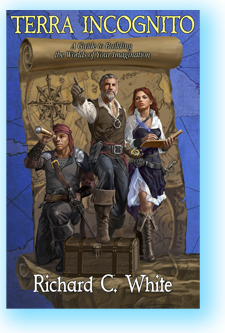 Fall is in full swing, and with it comes that annual November event called National Novel Writing Month. To explain what it is, I’ll let this quote from the organization’s website provide you with some background:
Fall is in full swing, and with it comes that annual November event called National Novel Writing Month. To explain what it is, I’ll let this quote from the organization’s website provide you with some background:
National Novel Writing Month (NaNoWriMo) is a fun, seat-of-your-pants approach to creative writing. On November 1, participants begin working towards the goal of writing a 50,000-word novel by 11:59 PM on November 30. Valuing enthusiasm, determination, and a deadline, NaNoWriMo is for anyone who has ever thought about writing a novel.
And what do you know? It just so happens that StarWarp Concepts has a book that’s perfect for writers!
Terra Incognito: A Guide to Building the Worlds of Your Imagination is our popular how-to book for writers and gamers in which bestselling fantasy author Richard C. White (For a Few Gold Pieces More,Gauntlet: Dark Legacy: Paths of Evil, The Chronicles of the Sea Dragon Special, Troubleshooters, Incorporated: Night Stalkings) takes you through the step-by-step process of constructing a world for your characters, from societies and governments to currency and religion. Included is an interview with New York Times bestselling author Tracy Hickman (Dragonlance) that discusses his methods of world building, as well as his creative experiences during his time as a designer for gaming company TSR, the original home of Dungeons & Dragons.
What you’ll find in its pages is information that’s vital for just about any writer, especially when it comes to world building, and Rich shows you how to do it:
Bonus! Because Rich’s interview with Hickman was so lengthy, and touched upon some topics that didn’t pertain to the world-building focus of Terra Incognito, I made the editorial decision to cut those parts from the final version of the book. However, if you want to discover what else Rich and Hickman discussed—including their shared experiences in the licensed-publishing writers market—then head over to Richard C. White’s blog and read all about it!
From its first publication, the book has been a hit with not just fantasy writers, but role-playing gamers as well. When it debuted in October 2015 at the e-book distributor DriveThru Fiction and its sister sites DriveThru RPG and RPGNow, it immediately shot to the #1 position on all three as their top-selling title, and then remained for weeks as DriveThru Fiction’s #1 Hottest Nonfiction Book and #1 Hottest How-To for Writers! If you’re a writer or gamer, you might just want to check it out. In fact, it’s currently being used as a textbook in the Interactive Media Design (i.e., game design) program at Becker College in Worchester, Massachusetts!
“I think Terra Incognito is a solid introduction to the subject of world building. The book succeeds in helping the aspiring writer in creating a skeletal framework for which to hang the moving parts required of a believable fictional setting.”—The Gaming Gang
Terra Incognito: A Guide to Building the Worlds of Your Imagination is available in print and digital formats, so visit its product page for ordering information.

 You remember Satana, don’t you? No, not the guitar-playing rock legend—that would be Carlos Santana of “Black Magic Woman” and “Oye Como Va” fame. I’m talking about Satana, the Devil’s Daughter, the red-haired succubus who made her debut in the black-and-white magazine Vampire Tales #3, published by Marvel Comics in 1973.
You remember Satana, don’t you? No, not the guitar-playing rock legend—that would be Carlos Santana of “Black Magic Woman” and “Oye Como Va” fame. I’m talking about Satana, the Devil’s Daughter, the red-haired succubus who made her debut in the black-and-white magazine Vampire Tales #3, published by Marvel Comics in 1973.
Created by Roy Thomas and John Romita Sr., Satana was, basically, Marvel’s attempt to create a knockoff of Warren Publishing’s popular outer-space femme fatale, Vampirella. She wore a skintight, cleavage-revealing costume (although Satana’s leaned closer to a superhero outfit than Vampi’s one-piece swimsuit), dealt with supernatural threats, was drawn by her own share of Spanish artists (including Vampirella’s Esteban Maroto), and had most of her adventures in black-and-white horror magazines. During that time, readers learned that Satana wasn’t just Daddy Satan’s Little Girl, she also had a brother—none other than shirtless exorcist Damien Hellstrom, better known as the Son of Satan! But while Damien fought to save souls in his role as a pseudo-superhero, Satana was only interested in eating them in her role as the ultimate temptress.
 However, where Marvel missed the boat was in not promoting Satana to series star and giving her her own magazine series—in fact, she made only three feature-cover appearances during her short 1970s run: The Haunt of Horror #5 (Dick Giordano art for a Chris Claremont story); Marvel Premiere #27 (Gil Kane art for another Claremont tale—but this one was a full-color comic); and Marvel Preview #7 (a Bob Larkin painting for, yes, another Claremont story, although that issue has become more well-known for being the first appearance of Guardians of the Galaxy member Rocket Raccoon). Mostly, though, Satana occupied Vampire Tales’ and Haunt of Horror’s back pages. Not a smart move—if you’re gonna go head-to-head with the queen of the bad girls, you can’t do it from backup-story land.
However, where Marvel missed the boat was in not promoting Satana to series star and giving her her own magazine series—in fact, she made only three feature-cover appearances during her short 1970s run: The Haunt of Horror #5 (Dick Giordano art for a Chris Claremont story); Marvel Premiere #27 (Gil Kane art for another Claremont tale—but this one was a full-color comic); and Marvel Preview #7 (a Bob Larkin painting for, yes, another Claremont story, although that issue has become more well-known for being the first appearance of Guardians of the Galaxy member Rocket Raccoon). Mostly, though, Satana occupied Vampire Tales’ and Haunt of Horror’s back pages. Not a smart move—if you’re gonna go head-to-head with the queen of the bad girls, you can’t do it from backup-story land.
Her situation turned even more bleak when Claremont went and killed her off in a two-part Marvel Team-Up get-together with Spider-Man and Doctor Strange. That was the end of Satana Hellstrom…until she was pulled from limbo in the 1990s to pop up in the occasional superhero comic in the years since—but still only as a supporting character, never the headliner.
(In retrospect, she could have had it worse—she could have suffered the destined-for-obscurity fate of Marvel’s other Vampi wannabe: Lilith, Daughter of Dracula. Who? you ask. Exactly.)
So why am I talking about Satana at the SWC blog, of all places? Well, because you might have heard of a character we publish who was inspired by both Satana and Vampirella: the soul-stealing succubus called Lorelei! Debuting in the 1989 small-press comic Lorelei One-Shot Special, Lori became such a popular indie character in the years that followed that she still remains the project I’m most known for—even more so than the three X-Men novels I wrote in the early 2000s!
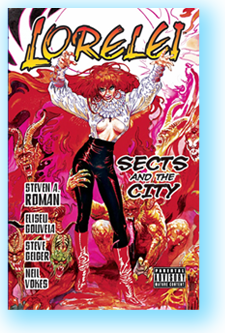 Lorelei currently stars in two critically acclaimed titles (no backup status for our girl!):
Lorelei currently stars in two critically acclaimed titles (no backup status for our girl!):
Lorelei: Sects and the City is a Mature Readers graphic novel in which Lori battles a cult of Elder God worshipers attempting to unleash hell on Earth. Basically a Lovecraftian love letter to 1970s horror comics like Vampirella, Tomb of Dracula, Ghost Rider, Son of Satan, and, of course, Satana, it’s written by yours truly, and illustrated by Eliseu Gouveia (The Saga of Pandora Zwieback, Lady Death), Steve Geiger (Web of Spider-Man, Incredible Hulk), and Neil Vokes (Flesh and Blood, Fright Night). It also features a cover by legendary artist Esteban Maroto (Vampirella, Zatanna, Satana), a frontispiece by original Vampirella artist Tom Sutton (Ghost Rider, Man-Thing, Werewolf by Night), and a one-page history of succubi drawn by Ernie Colon (Amethyst: Princess of Gemworld, Vlad the Impaler).
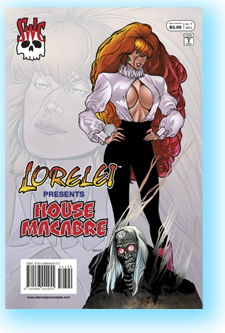 Lorelei Presents: House Macabre is Lori’s first outing as the hostess of a horror comic anthology, in this one-shot special that contains four tales of horror, behind eye-catching cover art by fan-favorite artist Louis Small Jr. (Vampirella, Supergirl, Batman 80-Page Giant). “The Old, Dark Manse” is written by me, penciled by Uriel Caton (JSA Annual, The Ex-Mutants, Heartstopper: The Legend of La Bella Tenebrosa), and inked by “Chainsaw” Chuck Majewski (Harvey Kurtzman’s New Two-Fisted Tales), and has Lori welcoming readers to this special. “All in Color for a Crime” is another tale from me, with art by Lou Manna (T.H.U.N.D.E.R. Agents, Young All-Stars). Two comic book collectors clash over a rare back issue—and only one of them will be adding it to their long boxes! “The Basilisk,” from me and artist John Pierard (Graphic Classics: Horror Classics, My Teacher Fried My Brains), is a “Lori’s Feary Tale” that examines the history of a supernatural creature that’s a cross between a deadly snake and a…chicken?! Wrapping up the special is “Requiem for Bravo 6,” by New York Times bestselling author and comic writer Dwight Jon Zimmerman (She-Hulk, Steve McQueen: Full-Throttle Cool) and artist Juan Carlos Abraldes Rendo (Bloke’s Terrible Tomb of Terror). A special-ops team goes on a life-or-death mission…but will they be prepared for what awaits them at mission’s end?
Lorelei Presents: House Macabre is Lori’s first outing as the hostess of a horror comic anthology, in this one-shot special that contains four tales of horror, behind eye-catching cover art by fan-favorite artist Louis Small Jr. (Vampirella, Supergirl, Batman 80-Page Giant). “The Old, Dark Manse” is written by me, penciled by Uriel Caton (JSA Annual, The Ex-Mutants, Heartstopper: The Legend of La Bella Tenebrosa), and inked by “Chainsaw” Chuck Majewski (Harvey Kurtzman’s New Two-Fisted Tales), and has Lori welcoming readers to this special. “All in Color for a Crime” is another tale from me, with art by Lou Manna (T.H.U.N.D.E.R. Agents, Young All-Stars). Two comic book collectors clash over a rare back issue—and only one of them will be adding it to their long boxes! “The Basilisk,” from me and artist John Pierard (Graphic Classics: Horror Classics, My Teacher Fried My Brains), is a “Lori’s Feary Tale” that examines the history of a supernatural creature that’s a cross between a deadly snake and a…chicken?! Wrapping up the special is “Requiem for Bravo 6,” by New York Times bestselling author and comic writer Dwight Jon Zimmerman (She-Hulk, Steve McQueen: Full-Throttle Cool) and artist Juan Carlos Abraldes Rendo (Bloke’s Terrible Tomb of Terror). A special-ops team goes on a life-or-death mission…but will they be prepared for what awaits them at mission’s end?
Lorelei: Sects and the City and Lorelei Presents: House Macabre are available in print and digital formats. Visit their respective product pages for ordering information, as well as sample pages.
So, happy anniversary, Satana, and thanks for the inspiration!